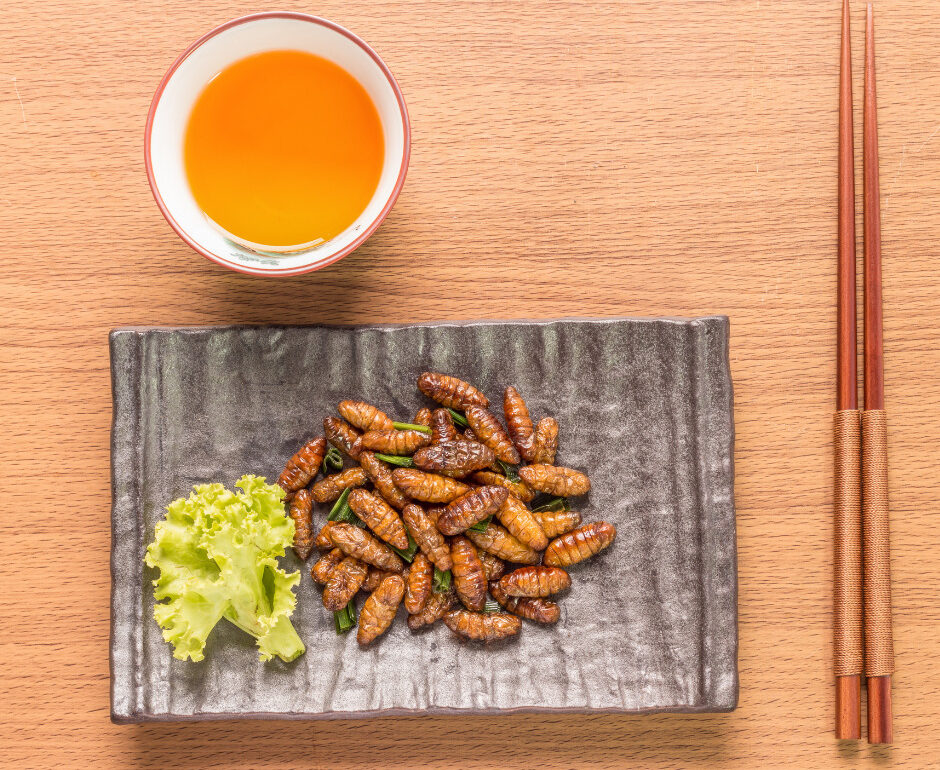Although eating insects is a new phenomenon in Europe, it is common elsewhere in the world. Insects are nutritious and using them as food would also help save the environment, say Kristel Vene, a food scientist at Tallinn University of Technology, and Lachin Huseynli, a doctoral student in food technology.
Earlier this year, the European Food Safety Authority gave a green light to using yellow mealworms (Tenebrio molitor) as food. The Estonian Ministry of Rural Affairs added that dried and ground insect species such as the house cricket (Acheta domesticus), tropical house cricket (Gryllodes sigillatus), migratory locust (Locusta migratoria), desert locust (Schistocerca gregaria), larvae of the beetle species Alphitobius diaperinus, honey bee pupae (Apis mellifera) and the larvae of the fly species Hermetia illucens may also be used as food.
However, proteins or fat isolated from insects was not allowed on food counters yet. This is novel food that has not been used extensively in the European Union before 1997, like for example, chia seeds and krill oil.
In the European Union, investment into insect farming is just beginning. The main producers of insect-derived food in Europe are Micronutris in France, Protifarm in the Netherlands, Entogourmet in Spain and Essento in Switzerland, but the potential of insect farms is also being studied by entomologists at the University of Tartu.
Insects as a delicacy?
While eating insects is something new in Europe, elsewhere in the world, insects have been on people’s tables for a long time and they are considered a delicacy. According to the Food and Agriculture Organisation of the United Nations, nearly 2.5 billion people in Africa, Asia and Latin America consume almost 2,000 varieties of insects as food that contain lots of valuable nutrients.
Now that legal restrictions are no longer an obstacle, we are facing a new challenge, which is the acceptance of insect-derived food in Europe. This is a concern, as the idea of insects on the dining table is considered quite disgusting by most people.
According to Giovanni Sogari, a social scientist at the University of Parma, the reason lies in the social and cultural background. Alan Yen, a researcher at La Trobe University, also finds that the main problem in Western societies lies in traditions and other cultural attitudes, in addition to the belief that insects are not food and therefore not wanted on dinner tables. Sogari believes that such attitudes may change over time and with experience.
Now, the key question is how to make eating cutlets or drinking smoothies made from insect meal acceptable and even pleasant. Several studies have been conducted on consumer acceptability, with one group knowing that the ingredients of the product have been partially replaced by insect meal, whereas the test group did not know.
In the test group, the acceptability of the products was as high as with conventional products, from which it can be concluded that the problem does not lie in taste, but is purely psychological. However, overcoming the reluctance associated with new foods is quite real – an analogy can be found in sushi. The publication Sifted stated that eating raw fish caused the same kind of disgust in Europe twenty years ago, but now sushi is the favourite food of many.
Why put insects on the table?
Insects are a suitable alternative to meat as they are good sources of protein and fat, and are rich in calcium, iron, zinc and the fibre chitin. A good example is mealworms, which contain the same amount of protein, vitamins and minerals as meat and fish. Grasshoppers also contain as much protein as lean minced beef, but less fat.
Looking beyond our personal diet, it must be acknowledged that there is a growing need in the world for nutrients, especially proteins and lipids. However, the livestock sector is unable to keep pace with the nutritional needs of the world’s growing population, as it requires additional resources.
According to Mario Mazzocchi, a professor at the University of Bologna, insect-derived food uses less feed than meat production, and less waste and greenhouse gases are produced. This means that insect-derived food generates greater economic benefits and decreases the environmental impact, as less land is generally needed for growing insects than other animals, which is also why the greenhouse gas emissions are lower.
Insect research at TalTech
The food science research group at TalTech, in collaboration with the Technical Research Centre of Finland (VTT), analyses valuable insects such as the larvae of the fly species Hermetia illucens. Hermetia illucens is a remarkable species in circular economy precisely because the larvae can compost 100 kilogrammes of protein from 2,000 kilogrammes of bio-waste.
We are studying their odour profile and chemical composition to pave the way for further taste research and, of course, their use in food.
Consumers’ attitudes towards food are mainly influenced by taste and smell. For example, Claudia Delicato and her colleagues at the University of Ghent have shown that in bakery products such as cakes, biscuits and waffles, where butter was partially replaced by lipids isolated from insects, its replacement to up to 25% did not cause any change in the overall experience or likeability of the bakery products. In wafer products, up to half of the butter could be replaced by the lipids without affecting consumer acceptability.
Substituting the fatty substance entirely is currently still difficult due to the development of off-flavours, and their prevention, elimination or encapsulation is the next challenge for odour scientists.
How do dried Hermetia illucens larvae smell?
If you have smelled dried fish, that’s exactly how they smell. The strongest molecules that give the larvae this smell of acidic fish or cheese are trimethylamine, butyric, acetic and 3-methylbutyric acids. “For ethical reasons, we have not tasted them, but since 85 per cent of the smell is taste, we can assume that their taste is similar to that of dried fish,” says the TalTech food scientist Kristel Vene. “Dogs like them a lot,” adds Vene’s colleague Tuure Parviainen from VTT.
Integrating insects into conventional food is difficult because the aromatic compounds in insect meal are often perceived by consumers as unpleasant off-flavours. One way to solve this problem is to distort or encapsulate the off-flavour. Some people try to add insects to foods where they taste as expected, such as fish dishes.
Some people, such as Matan Shelomi from the National Taiwan University, find that insects taste like insects, so they should be prepared accordingly. If insects are already a part of the diets of so many African and Asian people, then in one way or another, the food industry will find a way to add bugs to food in a way that is acceptable to people here as well.
The future: chocolate is redundant in insect chocolate
Even though overcoming disgust is time-consuming and arduous, we believe that one day we will even have conversations such as this: “I can’t eat your insect chocolate because chocolate isn’t good for my stomach.”
We are committed to developing future foods that are sustainable, tasty and economical. That is why researchers and the food industry are putting more effort into working with the sensory perception, and analysing how to make new foods and ingredients more acceptable to consumers.
The translation of this article from Estonian Public Broadcasting science news portal Novaator was funded by the European Regional Development Fund through Estonian Research Council.
 Back
Back



